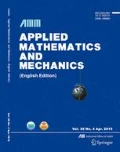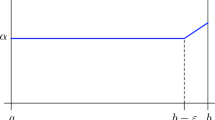Abstract
From the concept of four-dimensional space and under the four kinds of time limit conditions, some general theorems for elastodynamics are developed, such as the principle of possible work action, the virtual displacement principle, the virtual stress-momentum principle, the reciprocal theorems and the related theorems of time terminal conditions derived from it. The variational principles of potential energy action and complementary energy action, the H-W principles, the H-R principles and the constitutive variational principles for elastodynamics are obtained. Hamilton's principle, Toupin's work and the formulations of Ref. [5],[17]–[24] may be regarded as some special cases of the general principles given in the paper. By considering three cases: piecewise space-time domain, piecewise space domain, piecewise time domain, the piecewise variational principles including the potential, the complementary and the mixed energy action fashions are given. Finally, the general formulation of piecewise variational principles is derived. If the time dimension is not considered, the formulations obtained in the paper will become the corresponding ones for elastostatics.
Similar content being viewed by others
References
Love, A. E. H.,A Treatise on the Mathematical Theory of Elasticity, Cambridge University Press, Cambridge, 1st Ed. (1892); 4th Ed. (1927); Reprinted, Dover Publications, New York (1963).
Chien, W. Z. and Ye Kai-yuan,Theory of Elasticity, China Academic Publishers, Beijing (1958), (in Chinese)
Washizu, K.,Variational Methods in Elasticity and Plasticity, Pergamon Press, New York 1st Ed. (1968); 2nd Ed. (1975); 3rd Ed. (1982).
Rozin, L. A.,Variational Formulations of the Problems for Elastic Systems, Leningrad University Press, Leningrad (1978). (in Russian)
Oden, J. T., and J. N. Reddy,Variational Methods in Theoretical Mechanics, Springer-Verlag, New York, 1st Ed. (1976); 2nd Ed. (1983).
Chien, W. Z., Study on generalized variational principles in elasticity and their applications to finite element calculation,Mechanics and Practice,1, 1 (1979), 16–24,1, 2 (1979), 18–27. (in Chinese)
Chien, W. Z.,Variational Methods and Finite Element, China Academic Publishers, Beijing (1980). (in Chinese)
Guo Zhong-heng,Theory of nonlinear elasticity, China Academic Publishers, Beijing (1980). (in Chinese)
Hu Hai-chang,Variational Principles in Elasticity and Their Applications, China Academic Publishers, Beijing (1981). (in Chinese)
Long Yu-qiu, Subregion generalized variational principles in elasticity,Shanghai Journal of Mechanics,2, 2 (1981), 1–9. (in Chinese)
Rayleigh, L., Some general theorems relating to vibration,Proc. London Math. Soc.,4 (1873), 357–368.
Graffi, D., Sui teoremi di reciprocita nei fenomeni dipendenti dal tempo,Annali di Matematica,18 (1939), 173–200.
Andlef, N. N., Reciprocal theorems in theory of vibration and sound,Physical Dictionary,1 (1936), 458-. (in Russian)
Graffi, D., Über der reziprozitatsatz in der dynamik der elastischen korper,Ing. Arch.,22 (1954), 45–46.
Hu Hai-chang, On the reciprocal theorems in the dynamics of elastic bodies and some applications,Acta Mechanics Sinica,1, 1 (1957), 63–76.
Lamb, H., On reciprocal theorems in dynamics,London Math. Soc. Proc.,19 (1888), 144–151.
Toupin, R. A., A variational principle for the mesh-type analysis of a mechanical system,J. A. M.,19, 2 (1952), 151–152.
Crandall, S. H., Complementary extremum principles for dynamics,Ninth Int. Con. Appl. Mech.,5 (1957), 80–87.
Green, A. E. and W. Zerna,Theoretical Elasticity, Oxford University Press, London (1954).
Chen Yu, Remarks on variational principles in elastodynamics,J. Fran. Inst.,278, 1 (1964).
Truesdell, C. and R. A. Toupin, The classical field theories,Encyclopedia of Physics, S. Flugge, Ed.,3, 1 (1960).
Yu Yi-yuan, Generalized Hamilton's principles and variational equation of motion in nonlinear elasticity theory with application to plate theory,J. A. S. A.,36, 1 (1964), 111-
Barr, A. D. S., An extension of the Hu-Washizu variational principle in linear elasticity for dynamics problems,J. Appl. Mech.,33 (1966), 465-
Dean, T. S., and H. J. Plass, A dynamic variational principle for elastic bodies and its application to approximations in vibration problems,Devel. in Mech.,3, 2 (1965), 167-
Xing Jing-tang, Variational principles for elastodynamics and study upon the theory of mode synthesis methods, Master Thesis, Dept. of Engng. Mech., Tsinghua Univ., Beijing (1981). (in Chinese)
Xing Jing-tang and Zheng Zhao-chang, A study of mode synthesis methods based on variational principles for dynamic elasticity,Acta Mechanica Solida Sinica, 2 (1983), 248–257. (in Chinese)
Xing Jing-tang and Zheng Chao-chang, Some general theorems and generalized and piecegeneralized variational principles for elastodynamics, Reported at the Invitational China-American Workshop on Finite Element Method, Chengde, China (1986).
Xing Jing-tang, Some theoretical and computational aspects of finite element method and substructure-subdomain technique for dynamic analysis of the coupled fluid-solid interaction problems — variational principles for elastodynamics and linear theory of micropolar elasticity with their application to dynamic analysis, Ph. D. Dissertation Dept. of Engng. Mech., Tsinghua University, Beijing (1984). (in Chinese)
Xing Jing-tang and Zheng Zhao-chang, A review of Newmark and other time stepping formulae by applying generalized Hamilton principle,Shanghai Journal of Mechanics,6, 1 (1985), 19–28. (in Chinese)
Xing Jing-tang, Finite element-substructure method for dynamic analysis of coupled fluidsolid interaction problems,Proc. of Int. Conf. on Comp. Mech., Atturi S N, Yagawa G, Ed. Springer-Verlag, Tokyo, (1986), IX117-IX122.
Xing Jing-tang, Du Qing-hua and Zheng Chao-chang, The displacement finite element formulation of dynamic analysis of fluid-structure interaction problems and substructure-subdomain techniques,Proc. of Int. Conf. on Vib. Probs. in Engng., Du Qinghua, Ed. Xi'an Jiaotong University Press, Xi'an, 453–457.
Author information
Authors and Affiliations
Additional information
Communicated by Chien Wei-zang
Collected in the Proceedings of the Invitational China-American Workshop on Finite Element Methods, Chengde, People's Republic of China, June 2–6, 1986. Supported by the Doctorate Training Fund of National Education Commission of China.
Rights and permissions
About this article
Cite this article
Jing-tang, X., Zhao-chang, Z. some general theorems and generalized and piecewise generalized variational principles for linear elastodynamics. Appl Math Mech 13, 825–840 (1992). https://doi.org/10.1007/BF02481802
Received:
Issue Date:
DOI: https://doi.org/10.1007/BF02481802



